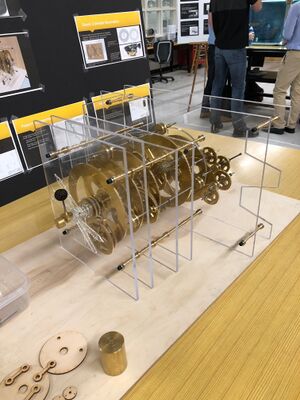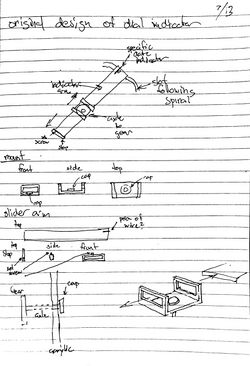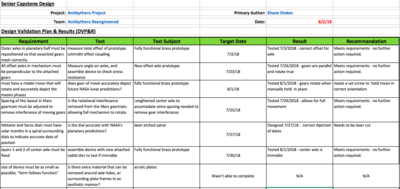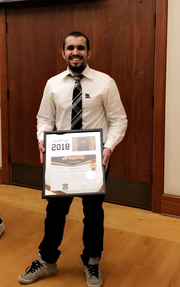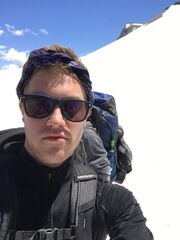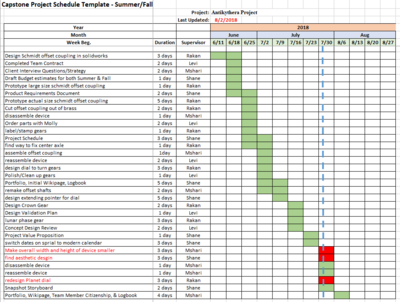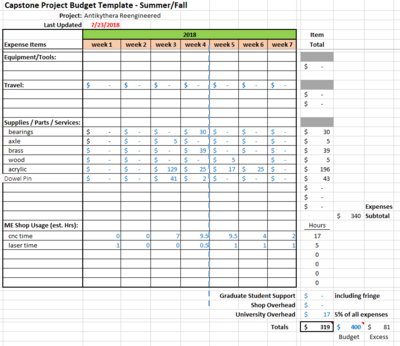Antikythera Planetary Prediction Mechanism
| [[File:|300px|center|alt=]] | |
| Antikythera Device at time of thesis presentation | |
| Sponsors | University of Idaho [1] |
| Team Name | Antikythera Reengineered |
| Duration | summer 2018 |
| Faculty Adviser |
|
| Mentor |
|
| Client |
|
| Team Members |
|
The goal of the project is to reengineer and create a prototype of an ancient Greek device that was used to predict astronomical portions of know celestial entities based on the Jian-Liang Lin and Hong-Sen Yan design.
Problem Definition[edit | edit source]
Background[edit | edit source]
The Antikythera Device was the world’s earliest computer. This mechanism, found off the island of Antikythera in the late 1800’s, was dated around 100 BC. The goal of this device was to use gear ratios to predict the positions of the moon and planets at a given date.
A University of Idaho Graduate Student, Alex Olson, created a prototype of this device, but had several unexpected problems. One set of gears in the planetary part of the device interfere with the outer axles. One axle that should be stationary, rotates due to an unsuccessful press fit. The date spiral needs to be designed to show what date the planets are at what position. The goal of this project is to solve the problems in the prototype and bring the machine to working condition. This will go in the Dean’s office, and show some of the projects that the University of Idaho students are capable of making. And the whole device is novel, because this will be the first fully operational version of itself in the United States, and the third in the world.
This project will be a relatively cheap (under $400) for getting the device to work. It will be interesting in the Dean’s office, and will be informational for both what the ancient Greek’s were able to make, and also where the planets will be at a certain date.
Product Requirements[edit | edit source]
- Schmit Offset couplings
- Check if two discs works instead of three
- Design in Solidworks
- Prototype large size
- Prototype actual size
- Find new location for third axle
- Secure axles on each side of couplings
- Create out of brass (get Bill’s help)
- Assemble couplings and device
- Straighten offset axles
- Check problem
- Assembled wrong?
- Material weakness?
- Fix problem
- Reassemble device
- Find way to fix center axle
- Glue?
- Less permanent way?
- Design spiral
- Switch dates from Greek calendar to modern calendar
- Design dial to turn gears
- Design extending pointer
- Find aesthetic design
- Make overall width and height smaller
- New material other than acrylic?
- Have to do this after date spiral is designed
- “form follows function”
- Lunar phase gear
- Can't use bevel because it wasn't invented yet
Design Considerations[edit | edit source]
Our deliverable that went through the most designing was the date spiral indicator. We had a total of 5 designs for it. This is the fourth design. The only difference between this and the final was the arm is cylindrical in the final.
The date spiral also took a lot of designing. We had to convert the dates from lunar to solar, translate the three minor dials, and design it in Solidworks. This was an early sketch of the Metonic dial.
The several other designs we went through are covered in the Project Learning of this wiki page.
Project Learning[edit | edit source]
Another large portion was attributed to parts manufacturing. Many of the designs being implemented were a proven concept and we reverse engineered them and downsized them to fit into the mechanism
Schmidt Offset Coupling[edit | edit source]
All of the offset couplings that can be purchased, use three discs to allow the axle to return to its original offset, but our project didn't require that, so our prototype was to determine if two discs would mess up the design. Our first prototype was made to test the functionality of the coupling when only two discs are used. We laser cut a 1 to 1 size to make sure it can be machined in house, also a 4 to 1 test the functionality. We ended up modifying the prototype make the discs OD bigger and the connecting arm thicker to support the coupling better. After modifying the dimensions of the first prototype, we asked our mentor, Sarah Willis, for her thoughts about the design and dimensions, and she suggested to adjust the dimensions to fit the assembly better and can be machined from the stocks left from Alex’s project. For the final design, We modified the dimensions to fit better with the assembly where the discs have a press fit center hole to allow it to rotate along with the shaft, and the connecting arms to have a slip fit to allow it to rotate freely to transfer the rotation to the other disc and shaft.
Date Spiral Indicator Design[edit | edit source]
Several designs were thrown around when the dial was being designed. The first was a tube with a spring in it to apply a constant pressure on the dial indicator, but Alex suggested that we should not use such a complex design like the spring underneath the cover plate shown in the first image. So we went back to the white board to come up with a new design. We received better feedback on the second design from Alex and Sarah, however, they pointed at that this design might cause binding with the spiral and it would get stuck while rotating and we needed to come up with another idea that might fix that. For the third design we used the same concept from the last prototype, however, we changed the pin sliding in the spiral from a square pin to two cylindrical pins to avoid binding and still have enough support to move the slider with ease. but we finally changed the design completely to match it with the design shown in the calendar schematics but still had the same concept of having a cylindrical pin. The design is based on the idea of having a stationary slider and a moving arm, unlike the third prototype which had a moving slider and stationary arm.
Recreated Acrylic Plates[edit | edit source]
When Alex originally cut the acrylic plates, he used cutting fluid in the CNC which caused a chemical reaction with the acrylic and created small cracks radiating out from any of the holes. We re-cut them, this time without using the fluid and this kept them intact.
Fixed Shaft[edit | edit source]
Level two of the main shaft (down the center of the device) needed to be kept stationary. We tried to use epoxy, but that cracked. There wasn't enough surface area to keep it strong. So we designed a bearing (like many of the other ones on the gears) to keep in stationary.
Stationary Axle[edit | edit source]
The original design to keep the smaller gears stationary in the outer planet phases was a press fit shaft in the acrylic, but it was almost impossible to assemble it without damaging the shaft. So we designed a new shaft that would be bolted to the acrylic itself and support the bearing on the large gear and the smaller one. A nut holds the gear tight and immobile against the bearing.
Flathead Screw Replacement[edit | edit source]
We are slowly replacing the 2-56 screws with 2-56 flathead screws to reduce the space the gears would take up.
Greek Calendar Recreation[edit | edit source]
The original greek calendar used on this device was a lunar calendar. This means that it goes by 12 lunar months instead of the 12 solar months we normally use. They are very close in length, but aren't completely the same. Over 19 years, the lunar calendar adds 7 months and this makes exactly 19 solar years. So 235 lunar months equal 228 solar months exactly. Our design was to have a slot in the spiral to force the dial to point to the correct date as the device rotates and turns the arm.
Lunar Phase Gear[edit | edit source]
The lunar phase contain three parts: Crown gear, Spur gear, Hub. The crown gear has an OD of 0.8125in and 26 teeth with a pitch of 32 teeth/in. The Spur gear has an OD of 0.817 and diameter pitch of 0.75 and 24 teeth with a pitch of 32 teeth/in. The crown gear is placed on the stationary shaft and tighten using a set-screw. The hub is placed on the moon shaft, which going to allow the shaft coming on the other side of the hub to rotate around indicating the location of the moon. The spur gear would also make the shaft rotate around itself by meshing with the crown gear. A model of the moon is placed on the shaft next to the spur gear that would show the state of the moon at a giving date.
Final Design[edit | edit source]
Summary[edit | edit source]
There were 6 main design requirements that drove this project: The offset couplings, offset axles, fixing the center axle, the date spiral, reducing the size of the overall device, and the lunar phase gear. We totally completed three of these (the coupling and both axle requirements). We also got the spiral translated and designed, but we didn't get it implemented in the device. We still needed to laser cut it. The size was a less important aspect of the design requirements, and since "form follows function" we couldn't really address that until we had everything completed and knew what aspects of the structure weren't required. The lunar phase gear was a last priority, but we were able to get to it and get it mostly prototyped. It still needs a set screw to lock the axle for the moon model in place. We were mostly on schedule though a few things took longer then we expected (see both Gantt chart versions). Our final design had a few unexpected hiccups, that was not included in the design requirements provided by the client. Gears had been drilled crooked which caused certain parts to interfere slightly with other gears. This will need to be fixed. And one of the planetary dials broke and will need to be re-manufactured. But otherwise, the device is operational, and all parties are happy with the completed parts of the design requirements.
Future Work[edit | edit source]
The device can be still worked on and developed to reach its potential of being a show piece for University of Idaho.
Redesign planet dials[edit | edit source]
The planet dials present on the device right now are cutout made out of acrylic, which are cracked and wore due to using machining coolant during the process of machining. The team had an idea of replacing the acrylic dials with a planetary set of marbles. Each marble will have the size and color of the planet of in the system, creating a more visually appealing look to the front of the device. In order to make this change, there is preparatory step to take first. The planetary Shafts need to be replaced with longer shafts to have enough space in the front of the device for the marbles to rotate and avoid collision with one another.
360 degree indicator on the front plate[edit | edit source]
At this moment, the planets’ dials can rotate and point in the right direction. However, it’s not easy to understand where exactly are they pointing at. By adding a 360 degree engraving on the acrylic or a wooden plate attached to the front, the viewer can understand where the planets are in the sky at any giving day.
The Greek Calendar Recreation[edit | edit source]
The calendar is a big missing part of the device. The team worked on recreating the calendar and translating the Greek calendar to an English solar calendar. We have managed to translate the months and create a first prototype of the calendar, but there’s still a lot more work to be done.
Validation[edit | edit source]
Team Members[edit | edit source]
| Name: Mshari Aldossary Major: Engineering
| |
| Name: Rakan Alshannan Major: Engineering
| |
| Name: Shane Stokes Major: Engineering
| |
| Name: Levi Vogel Major: Mechanical Engineering
|
Additional Documentation[edit | edit source]
Project Schedule[edit | edit source]
Meeting Minutes[edit | edit source]
Meeting 1 – 6/19[edit | edit source]
12:00 – Re-asked Alex questions so that the professors knew what was going on
Scale down and implement offset couplings into mechanism
Will compensate for meshing of different gear ratios, as well as allowing for clearance of rotating gears
Rebuild some offset shafts to better align gears for a cleaner mesh
Rebuild acrylic frames to hold new offset couplings, possibly implement aesthetic design into acrylic
Create a new modern interpretation of the Greek calendar with a pointer and slider implementation
12:30 – Review list of Project deliverables
Attendees:[edit | edit source]
Beyerlein Odom Sarah Alex Rakan Mshari Shane
Notes:[edit | edit source]
- Levi was taking FE
Meeting 2 – 6/26[edit | edit source]
12:30 – Develop product requirements
Prototypes began
Move device to meteorology lab
Show validation of design/changes
Implement into 3-D model
Use or modify old frame plates to show fitment
Create simple quick prototypes
12:45 – talked with Odom about future form of plates in device
Attendees:[edit | edit source]
Mshari Rakan Shane Levi Sarah Alex Beyerlein
Notes:[edit | edit source]
- Don’t completely loosen the lantern gears set screws
- Third offset only needs to be supported on opposite end of shaft
- Input gear will mesh with gear #32
- Move/relocate shaft for gears #12 and #28
- Build press fit hub for stationary shaft? Use glue?
Meeting 3 – 7/3[edit | edit source]
12:00 – got Swenson up to date on project and requirements and schedule
12:05 – discussed ideas for dial to indicated date for spiral
12:10 - disscuss work schedule
Verify if we are on track, and what tasks have been completed
12:30 – decided week’s work plan:
Monday 7/2: Rakan and Mshari began design work on calendar dial mechanism
Tuesday 7/3: Ordered Parts will arrive; assemble offset couplings
Thursday 7/5: remake acrylic plates; rebuild offset shafts
Friday 7/6: crass shaft arrives; reassemble mechanism or rebuild plates
Attendees:[edit | edit source]
Mshari Rakan Shane Levi Sarah Alex Swenson
Post meeting notes:[edit | edit source]
- Find system for tracking revisions in files
- Alex will be gone by 7/30
Meeting 4 – 7/10/2018[edit | edit source]
12:00 – run through schedule and where we are in the tasks
working on machining plates
working on spiral design
12:05 – how to cut the offset axle
do we need set screws?
12:07 - spiral date indicator
two slots?
Brass slider instead of acrylic
Keep it from jamming
12:09 – move concept design review to next week
12:10 – spiral design
sprials are the same size
marks show where eclipses are
12:15 – Machining plates
make sure they are in the right place
12:16 – design review is moved to next week
Attendees:[edit | edit source]
Mshari Rakan Shane Levi Sarah Alex Swenson
Notes:[edit | edit source]
- Strikethrough for finished tasks on top of color
- Move design review to Wednesday at noon
Meeting 5 – 7/17/2018[edit | edit source]
12:00 - Review before the Design review.
12:05 - Discuss ; remake of offset shafts – Possible outsource.
12:10 - Look into ordering second smallest shaft
12:13 - Asking Bill about cutting to size.
12:15 - Look over plate spaces decide on Length need/Lathe coding.
12:20 - Slides Review: (Suggestions) • Address: Crown Gear, offset shaft
• Number of Slides
• Prospective for offset , coupling placement.
• Bring in Mechanism to presentation .
• Slides > Show DVP
• Consider slider having on open end.
• The presentation will be in EP 209.
• Epoxy in Pins to offset couplings.
• Restrain shafts from separating coupling.
• Change the team name.
• Fix “Project Learning” >> “ Project Management”
• Look into “Schmitt coupling” name.
• Coupling animation > Clear front disk.
• Back plate >> Extra holes.
• Add table for equations on offset.
• Include remade calendar from Alex’s thesis.
• Point Dial Pins arc.
• Add slide for QUESTIONS.
• Add animations to Questions slide.
Attendees:[edit | edit source]
Mshari Rakan Levi Alex Sarah Swenson
Notes:[edit | edit source]
- Presentation at 12:00 pm. EP 209
- Tell Bill about our presentation and the location.
- Shane was at a wedding so was not able to attend
Meeting 6– 7/24/2018[edit | edit source]
11:30 – Project Value Proposition evaluation
• First couple paragraphs are good
• shorten 11:35 – Spiral Date reset after 19 years • figure out design requirements
11:55 - final things
12:00 – need better meeting agenda
Attendees:[edit | edit source]
Mshari Rakan Levi Shane Sarah Swenson
Notes:[edit | edit source]
- email alex about way to reset date indicator
- have better meeting agenda
- “always go back to the requirements” – Swenson
Meeting 7– 7/31/2018[edit | edit source]
12:00 – Review of Schedule
12:03 - Gear don't spin totally true
12:07 - redesign planet dials'
• might not get to that this summer
12:09 - Portfolio should contain what parts weren't able to be completed
12:13 - update budget
12:15 - remove last paragraph of project value proposition
Attendees:[edit | edit source]
Mshari Rakan Levi Shane Dr Swenson
Notes:[edit | edit source]
- remove last paragraph
- team member citizenship form
- zero out budget
Project Budget[edit | edit source]
Client Interview[edit | edit source]
File:Antikythera Client Interview.pdf
